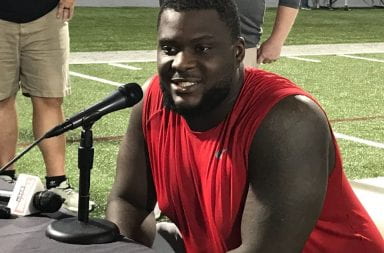
When the semester turned virtual before Thanksgiving break, some students returned home to inadequate internet access. Credit: Lantern File Photo
Rather than home offices or bedrooms, some students will finish fall semester in a local fast-food restaurant’s parking lot just to access their exams.
When the semester turned virtual before Thanksgiving break, some students returned home to inadequate internet access. For final exams this semester, those students have to go the extra mile to access schoolwork remotely.
Schelby Beach, a fourth-year in agricultural communications and journalism, said she had problems submitting assignments in the spring because her internet connection couldn’t handle uploading files that large. She lives outside of Findlay, Ohio, and said she would drive into town and connect to public WiFi to turn in work.
This week, Beach has a final exam on Proctorio, an internet-based remote proctoring service. She said she’s worried something might go wrong if she tries it on her home WiFi.
“I’ve done it with my school internet and it was fine, but since I’ve been home, I haven’t used it yet,” Beach said.
Apart from exams, Beach said there are only two or three areas in her house where the internet supports Zoom classes, and even in those spots, the video buffers a lot during the session.
“Anytime I would have to speak in class, it lags like five seconds,” Beach said. “You’re behind trying to speak and then you’re not really in pace with what’s going on.”
In a June survey about the spring transition to online learning, 84 percent of Ohio State students indicated they had adequate internet access, 13 percent said they didn’t and 3 percent indicated neither.
In another question asking students to rank the biggest challenges to online learning, 31 percent selected limited internet access, according to the survey.
“What that tells me is that while they may have access to internet that at some points feels adequate, a greater number of students were still experiencing some sort of challenge with their internet connectivity,” Jessica Phillips, associate director of student experience for the Office of Distance Education and eLearning, said. “It probably has to do with bandwidth, it probably has to do with needing to stream videos, take exams.”
Madison Conley, a fourth-year in public health, said her household internet is too slow to support most of her school work. She and her sister, Maci, a second-year in health sciences, typically use a hotspot on their phones to access Carmen and Zoom classes.
Madison Conley said her family didn’t always have an unlimited data plan that allowed her to use a hotspot for schoolwork, but as she relied more on the hotspot, they opted to change plans.
“That might be something that other people are struggling with,” Conley said. “We’re just lucky enough that we can afford it.”
Phillips said inadequate access to the internet for classwork could extend beyond academics and cause students to miss out on other resources for food insecurity or counseling services.
“We did find a bit of that in the spring. It wasn’t a majority of students, but it was enough to raise concerns,” Phillips said.
Drawing from lessons learned in the spring, Phillips said the university is prepared to offer more holistic resources to support students this fall. Students can apply to the Together as Buckeyes emergency grants program for a variety of financial needs, including funding for internet access.
Resources: students can apply to the Together as Buckeyes Emergency fund here and view internet-access resources here.


